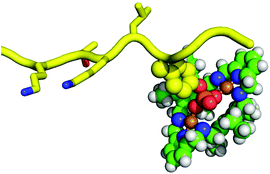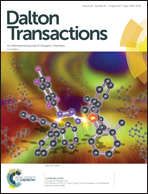Recognition of phosphopeptides by a dinuclear copper(ii) macrocyclic complex in a water : methanol 50 : 50 v/v solution†
Abstract
A new triethylbenzene-derived tetraazamacrocycle containing pyridyl spacers, L, was prepared and its dinuclear copper(II) complex was used as a receptor for the recognition of phosphorylated peptides in aqueous solution. A detailed study of the acid–base behaviour of L and its copper(II) complexation properties as well as of the cascade species with phosphorylated anions including two peptidic substrates was carried out in a H2O/MeOH (50 : 50 v/v) solution using different techniques, such as potentiometry, X-band EPR and DFT calculations. The association constants of the dinuclear receptor with the phosphorylated peptides and other anionic species revealed a clear preference towards phenylic phosphorylated substrates, with values ranging 3.96–5.35 log units. Single-crystal X-ray diffraction determination of the dicopper(II) complex of L showed the copper centres at a distance of 5.812(1) Å from one another, with the phosphate group of the PhPO42− substrate well accommodated between them. X-band EPR studies indicated a similar structure for this cascade complex and for the other cascade complexes with the phosphorylated anions studied. DFT studies of the [Cu2L(μ-OH)]3+ complex revealed a different conformation of the ligand that brings the two copper centres at a very short distance of 3.94 Å aided by the presence of a bridging hydroxide anion that provides a Cu⋯O⋯Cu angle of 167.3°. This complex is EPR silent, in line with the singlet ground state obtained using CASSCF(2,2) calculations and DFT calculations with the broken-symmetry approach. This species coexists in solution with a complex in a different conformation, and having a Cu⋯Cu distance of 6.63 Å, in lower percentage.



 Please wait while we load your content...
Please wait while we load your content...